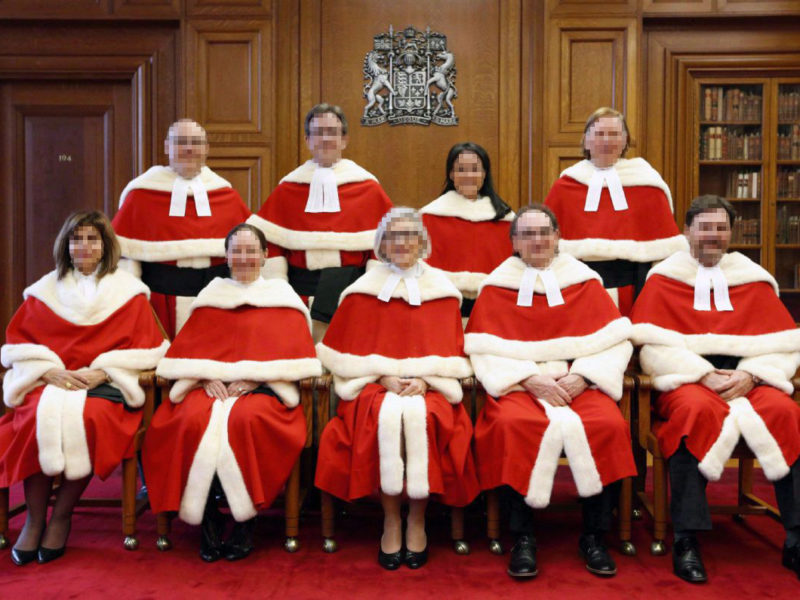Most Halloween stories involve ghosts, monsters or other unprovable phenomena. This may be fine for other countries, but Canada is at times a giant expanse of fog, snow, isolation...and madness: We generally don’t need tall tales to get creeped out.
Below are 11 events pulled directly from the pages of Canadian history that aren’t just bone-chilling, but entirely true.
Buried alive
Go to any historical graveyard in Canada and it’s likely that some of the coffin lids will feature scratch marks. Before the advent of modern medical monitoring, a few hours of unconsciousness could be all your loved ones needed to consign you to the nightmare of premature burial. A particularly chilling case was documented in Woodstock, Ontario in 1886. As the New York Times reported, a “girl named Collins” was being exhumed in order to move her to another burial place. When the coffin lid was removed, exhumers gazed in horror at evidence of dreadful torture. “Her shroud was torn into shreds, her knees were drawn up to her chin, one of her arms was twisted under her head,” the report stated.
Invasion of ghosts

Owen Beattie The perfectly preserved hand of John Torrington, an early Franklin Expedition casualty who largely dodged the total horror of the expedition's final months.
The small party of Inuit camped at the southern end of King William Island around 1850 could count themselves as one of the most isolated people on earth: They had never met white people, they had never met Dene and they barely encountered other Inuit. So it was a uniquely terrifying experience for them to hear the sound of footsteps outside their igloo and find themselves facing a crowd of lurching figures with eyes vacant, skin blue, unable to talk and barely alive. These were the last remnants of the ill-fated Franklin Expedition, the 1845 British voyage of Arctic exploration that ended with the death of all aboard. As ragged bands of expedition survivors split up and trudged south in a desperate bid to flee the Arctic on foot, Inuit throughout the region faced a real-life invasion of the walking dead. They saw men raving wildly, they saw camps strewn with emaciated corpses and they saw the Europeans begin to eat their dead. “They’re not Inuit; they’re not human,” was how one witness described their arrival, according to Inuit oral history.
The ghost soldier
Canadian soldier Will Bird is one of the most celebrated memoirists of the First World War, with veterans often citing his work as the most realistic portrayal of trench warfare. Bird also believed that he fought his First World War in the constant company of ghosts. His brother Stephen had been killed on the Western Front in 1915, and Bird wrote that he decided to enlist after the spectre of Stephen appeared before him on a Saskatchewan farm in full uniform. In an even more fantastical occurrence, Bird was a corporal serving in France in 1917 when he reported being shaken awake by Stephen’s ghost. “Get your gear,” the ghost told Bird before leading him on a short meandering walk down a trench. The next morning Bird discovered that his original sleeping spot had been shattered by a high explosive shell, and he forever credited his survival to the watchful hands of his dead brother. Canadian historian Tim Cook found that Bird’s experience was not unique, and that many soldiers returned from the Western Front with the belief that they too had served time in an ethereal land of the dead. As one Canadian infantryman put it:“You could feel the pulse of the thousands of the dead with their pale hands protruding through the mud here and there and seeming to beckon you.”

A seascape of corpses, Nova Scotia Archives: Crew members of the recovery ship CS Minia pulling a lifebelted Titanic victim from the sea.
Most survivors of the RMS Titanic never fully glimpsed the carnage of the sinking’s aftermath. Lifeboats had spent the night vigorously rowing away from the wreck and were well outside the main debris field when picked up by rescuers. Instead, the awful spectre of 1,500 floating bodies would be left for Canadians to encounter. Four ships were chartered out of Halifax to recover the Titanic’s victims, fating crew members to spend days living and working in a lonely patch of the North Atlantic inhabited only by endless fields of open-mouthed lifejacketed corpses. “Started to pick up bodies at six a.m. and continued all day till five thirty p.m.,” reads the diary of a crew member on the Mackay-Bennett, a cable ship that would handle more than 300 Titanic victims.
The Kaiser’s UFOs
Every day, Canadians phone in an average of three sightings of unidentified flying objects, according to the Canadian UFO Survey. One hundred years ago, the country was experiencing a similar rash of UFO encounters. All across Ontario and Quebec came sightings of low-flying objects emitting guttural drones and sweeping the landscape with powerful searchlights. Parliament Hill was put into lockdown in February 1915 by reports of four of the objects cruising toward Ottawa dropping “light balls” as they went. In 1916, railway guards in Tillsonburg, Ontario opened fire on a shadowy figure they believed had been brought by one of the flying machines. Canadians didn’t think these were extraterrestrials; they thought they were Germans. German aircraft of the age could barely cross the English Channel and yet Canadians were convinced that the Kaiser’s airmen were threatening Canada from secret bases in the United States. Subsequent analysis of the sightings concluded that they had been sparked by little more than boat motors, kites and even straight-up hallucination.
The ship of the dead
Site historique maritime de la Pointe-au-Père: The recovered bodies of Empress of Ireland victims.
Rammed by a coal ship in the St. Lawrence River in 1914, the Empress of Ireland took only 14 minutes to go down, taking 1,012 people with her. Located in only 40 metres of water near Rimouski, Que., the ship has been a well-known site for salvage divers almost from the beginning. But anyone entering the wreck knows they must navigate hallways and staterooms utterly choked with the bodies of men, women and children who spent their last moments in the frantic, clawing terror of a pitch black tomb quickly filling with icy water. The first brass-helmeted divers to explore the ship in 1914 reported shining their dim lanterns at crowds of bloated pale faces contorted in horror. Today, the victims are skeletons, and lie so thick within the wreck that divers have nicknamed it “the boneyard.”
The vanished airplane
San Diego Air and Space Museum Archives: A Lockheed Lodestar similar to the one lost over Vancouver in 1947.
In April, 1947 the Vancouver airport received a routine radio call from Trans Canada Flight 3 from Lethbridge: The plane was banking over the Pacific Ocean for its final approach and would be touching down shortly. But the plane, a Lockheed Lodestar with 15 passengers and crew aboard, never emerged from the clouds. A search the next morning revealed no signs of violence: No wreckage, no smoke, no witnesses who could report hearing the telltale sound of a plane slamming into the ground. A twin engine plane had vanished from the sky overtop the largest city in Western Canada and nobody had seen a thing. It was only in 1994 that Vancouverites discovered the truth: Flight 3 had spent nearly 50 years in the city’s very backyard of the North Shore mountains.
The occult prime minister
Library and Archives Canada: Shirley Temple and W.L. Mackenzie King launch a war bond on Parliament Hill, Oct. 21, 1944.
It’s often said that Mackenzie King believed he could communicate with the ghost of his dead mother. This didn’t used to be all that unusual: Spiritualism was the yoga of its day, attracting devotees ranging from author Arthur Conan Doyle to Mary Todd Lincoln. But what is less known is just how much faith King put in the world of the occult. He took leadership advice from the ghost of Franklin Delano Roosevelt. He was obsessed with patterns, basing momentous decisions on, say, the symmetry of a nearby clock face. In a particularly unhinged moment, King travelled to Nazi Germany in a euphoric haze believing that he alone had been placed on earth to meet Adolf Hitler and bring peace to an unsettled Europe. Almost none of King’s unorthodox beliefs were known to the millions who voted for him. It would be akin to finding out that Brian Mulroney had decided to implement the GST after being instructed by secret messages hidden in Beatles records.
The mad trapper
The hooded figurine
Deborah Sabo and George Sabo: A medieval Inuit carving of a non Inuit visitor.
As they dug into the foundations of an ancient proto-Inuit house on Baffin Island, archaeologists George and Deborah Sabo were turning up the usual artifacts: Bones, baleen, harpoon heads, bits of wood. But then, their tools unearthed something downright eerie: A faceless man in a hooded robe with a simple cross emblazoned on his chest. To any modern Westerner the figure was instantly recognizable as a member of the Roman Catholic clergy. But to nomadic Thule people living at the time of the Middle Ages, it should have been a figure as alien as a Martian. To the Sabos, the eerie figurine was proof that the mythical Helluland mentioned in Viking sagas wasn’t mythical at all; it had been in Arctic Canada all along. Vikings had indeed walked these lands, met the inhabitants and left an impression — before vanishing as mysteriously as they had come.
The phantom terror attack
In May, 2004 a mysterious, olive-skinned man disembarking Vancouver’s number 98 bus offered an eerie remark to the driver. “How’s your day going?” said the man. When the driver replied that it was going well, the man replied “it won’t be for long.” Ten kilometers later, the bus driver was overcome by nausea and threw up. With other passengers reporting similar symptoms, the driver pulled over and radioed for help. Paramedics arrived on scene and they too fell ill. The whole episode carried the trademarks of a new and terrifying form of chemical terror attack. But Vancouver’s Chief Medical Health Officer, John Blatherwick, concluded that the true cause of the incident was weirder still: Nothing. There was no chemical and there were no terrorists, a cryptic comment had simply plunged an entire group of Vancouver strangers — including trained emergency personnel — into a state of sudden mass hysteria.























